Indus River (original) (raw)
Also referred to as the “Sindhu”, the Indus River is a long transboundary river in the Continent of Asia that is shared by the countries of China, India, and Pakistan. Rising in Western Tibet, the river flows for more than 3,180km and is considered as one of the world’s largest rivers and the longest river in Pakistan. The Indus river’s total drainage area is approximately 1,165,000 sq. km, of which 453,000 sq. km falls within the Himalayan ranges, the Karakoram Range, and the Hindu Kush mountains, while the remaining part lies in the desert plains of Pakistan.
Geography
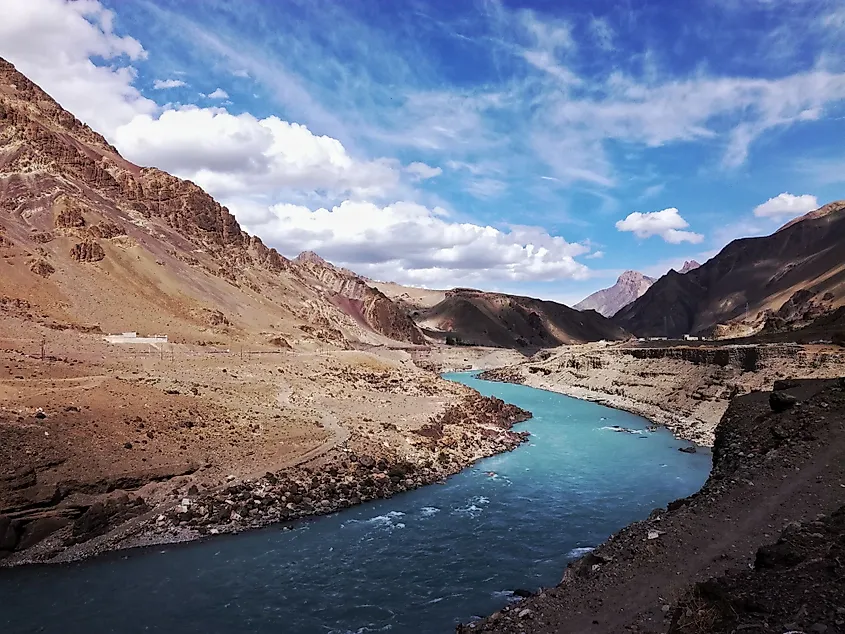
Indus River.
The Indus River originates close to Lake Mansarovar on the northern slopes of the sacred Kailash Mountain Ranges in the Tibetan Plateau. The headwaters of the Indus River start at the meeting point of the Sengge Zangbo (“Lions Mouth”) and the Gar Tsangpo rivers that drain the high Gangdise Shan and the Nganglong Kangri Mountain ranges of southwestern Tibet. The river then flows northwestwards through the Indian Union Territory of Ladakh and the Gilgit-Baltistan region of the Pakistan-administered Kashmir. After crossing the northern and western sides of the Nanga Parbat massif, the river then flows westwards and turns in the south and southwest directions to enter the Islamic Republic of Pakistan’s Khyber Pakhtunkhwa province. The Indus then flows as a rapid mountain stream till it reaches the Tarbela Dam reservoir. Just above the city of Attock, the river flows at an elevation of 600m and is crossed by its first rail and road bridge. The Indus then cuts across the Salt Range and enters the Punjab region of Pakistan. After receiving its major tributaries in the Punjab region, the Indus River and flows across the plains in the Sindh Province of Pakistan. The Indus River finally drains into the Arabian Sea via the large Indus River Delta near the port city of Karachi.
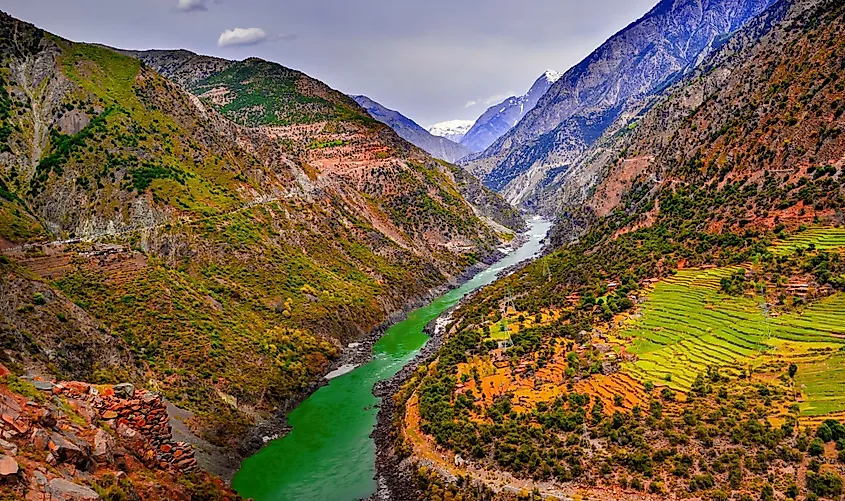
Aerial view of the Indus River Valley in Karakoram, Pakistan.
The Indus River is fed by numerous glaciers and small rivers of the Himalayan, Hindu Kush, and Karakoram Mountain ranges. Some of the major tributaries of the Indus include the Zanskar River, the Shyok River, the Shigar River, the Gilgit River, the Astor River, the Kabul River, the Kurram River, the Gomal River, the Jhelum River, the Chenab River, the Beas River, the Ravi River, and the Sutlej River. The five major tributaries of the River Indus – Beas, Ravi, Chenab, Jhelum, and Sutlej (“Panjnad”), give the name to the region of Punjab (“the land of five rivers”) that is divided between the countries of India and Pakistan. Adjacent to the town of Tatta, in Pakistan’s Sindh Province, the Indus divides into many distributaries that form a large delta before draining into the Arabian Sea. The Indus River Delta covers an area of more than 7,800 sq. km and extends along the coast for about 120km.
The Indus River and its tributaries together make up the Indus Basin, which spans four countries (China, India, Pakistan, and Afghanistan) and supports a population of about 300 million people. The Indus River provides water to the Indus submarine fan, which is considered the planet’s 2nd largest sediment body.
Climate
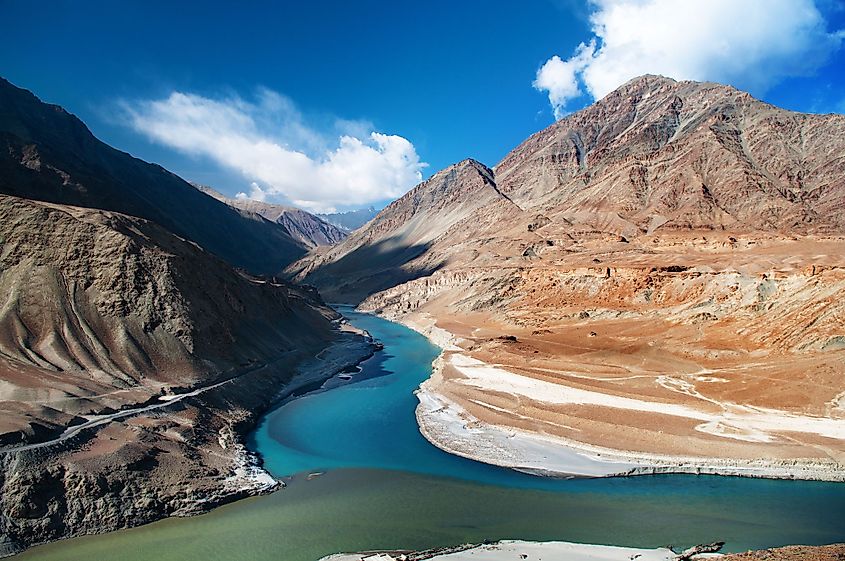
The Confluence of Zanskar and Indus Rivers in Leh, Ladakh, India.
The climate of the Indus River Basin varies from subtropical arid and semiarid to temperate subhumid on the plains of Pakistan’s Punjab and Sindh Provinces to alpine climatic conditions in the north. In the lowlands, the annual precipitation ranges between 100 and 500mm whereas in the mountain slopes the precipitation is about 2,000mm.
Since the tributaries of the Indus River are snow-fed, their flow varies greatly throughout the year, with minimum discharge during the winter months of December to February. There is a rise in the water level during the early summer and spring seasons from March to June and floods occur during the monsoon season from July to September. The river is also prone to flooding during the monsoon season. The estimated annual flow of the Indus River is 243km3, which is about two times that of the Nile River and three times that of the combined Tigris-Euphrates Rivers. Therefore, Indus is considered one of the world’s largest rivers in terms of average annual flow. It is also one of the world’s few rivers to exhibit a tidal bore.
Flora and Fauna
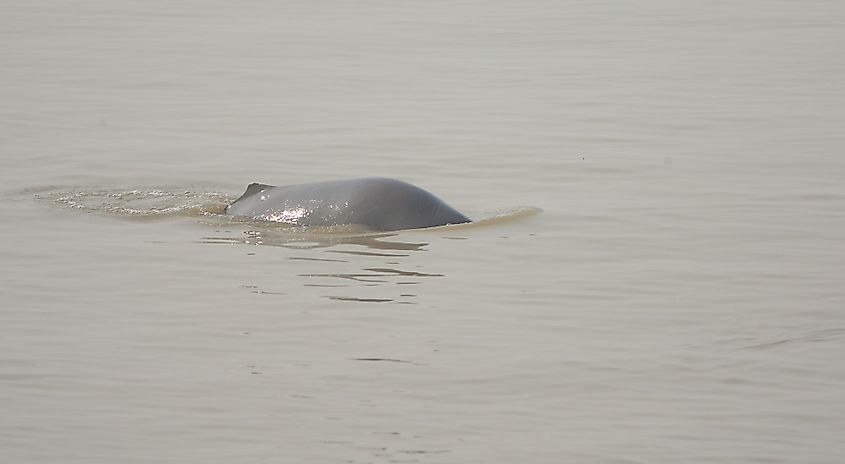
Indus river Dolphin, Pakistan.
It is believed that in earlier times the Indus valley had a healthy forest cover which has currently receded greatly. Due to extensive deforestation, there has been a deterioration in the vegetation of the region. However, the Indus River and its entire watershed have a rich biodiversity. It has been reported that there are about 25 amphibian species and over 180 freshwater fish species in the Indus River Basin. Some of the notable fishes that are found here include Palla fish, Cirrhinus mrigala, Rohu, Catla, chameleon fish, glassfish, schilbid catfish, etc. The highly threatened Indus river dolphin (Platanista indicus minor) is endemic to the Indus River. Two species of otters are found in the Indus River Basin. These include the Eurasian otter and the smooth-coated otter. A subspecies of the smooth-coated otter – the Sindh otter is endemic to the Indus River.
Brief History
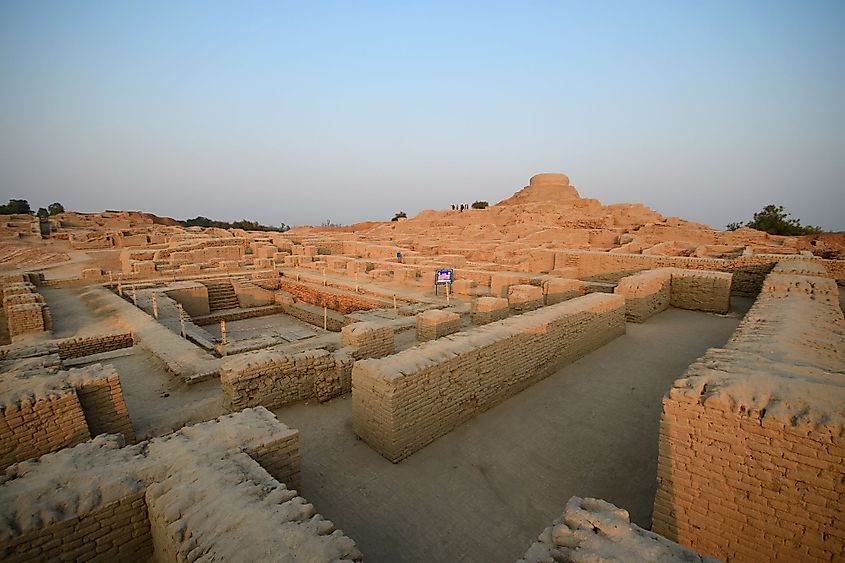
Mohenjo-Daro, archaeological site in Sindh Province, Pakistan.
The region that is drained by the Indus River and its tributaries served as the site of the famous Indus Valley Civilization. The principal cities of the Indus valley civilization, Harappa and Mohenjo-Daro were located along the banks of the river. Archaeological excavations have revealed that the Indus Valley civilization extended from the northeastern part of Afghanistan to Pakistan and the northwestern part of India. Archaeologists have discovered over 1,052 cities and settlements of the civilization in this region. The Persian Empire became the first Western Empire to annex the Indus Valley. The river was also crossed by the invading armies of Alexander the Great. Later, the Indus Valley was dominated by several empires including the Mauryans, the Kushans, and the Muslim rulers like Babur, Mahmud of Ghazni, and Mohammed Ghori.
The Indus River finds mention in the Rigveda with the name of “Sindhu”. It is believed that the country name “India” has also been derived from the name of the Indus River. The name “Indus” has been derived from the Persian word “Hindu” which itself has been derived from the Sanskrit word “Sindhu”. The ancient Greeks referred to the Persian word “Hindu” as “Indos” and the Indians as Indoi, which translates to the “The People of the Indus”.
Economy
The Indus River is of immense economic importance to the countries of India, China, and Pakistan. The Indus River is the most crucial water supplier in the plains of Punjab and Sindh. As the largest river of Pakistan, it forms the backbone of the country’s agricultural economy. Since the Indus Valley Civilization, the waters of the river have been used for irrigation purposes in the semi-arid regions. During the British colonial period, large canal systems were constructed, which eventually formed one of the world’s most complex irrigation networks. In 1960, the Indus Water Treaty was signed between India and Pakistan, where it was decided that the waters of the Ravi, Sutlej, and Beas rivers would be exclusively used by India, while the waters of the Indus, Jhelum, and Chenab rivers would be exclusively used by Pakistan.
Some of the barrages that have been constructed on the Indus in Pakistan include the Guddu Barrage, the Kotri Barrage, the Sukkur Barrage, the Jinnah Barrage, the Chashma Barrage, and the Taunsa Barrage. These irrigation projects support the production of economically important crops like cotton, sugarcane, wheat as well as helps in the generation of hydroelectricity. In India also, several dams and link canals have been built along the Indus River.